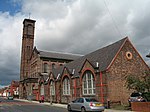Edge Hill Intercity Depot
Rail transport in MerseysideRailway depots in EnglandUse British English from December 2016

Edge Hill Intercity Depot is a traction maintenance depot located in Edge Hill, Merseyside, England. The depot is situated at the junction of the Liverpool to Manchester Line and the Crewe to Liverpool Line, and is located to the east of Edge Hill station. The depot is built on the site of the former Cheshire Lines Committee Wavertree and Edge Hill goods station. The depot code is LL.
Excerpt from the Wikipedia article Edge Hill Intercity Depot (License: CC BY-SA 3.0, Authors, Images).Edge Hill Intercity Depot
Picton Road, Liverpool Wavertree
Geographical coordinates (GPS) Address Nearby Places Show on map
Geographical coordinates (GPS)
| Latitude | Longitude |
|---|---|
| N 53.4034 ° | E -2.9358 ° |
Address
PICTON ROAD/B.R.RAIL MAINTENANCE DEPOT
Picton Road
L15 4LH Liverpool, Wavertree
England, United Kingdom
Open on Google Maps







